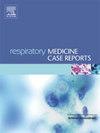egfr突变型肺腺癌转化为小细胞肺癌1例报告并文献复习
IF 0.8
Q4 RESPIRATORY SYSTEM
引用次数: 0
摘要
分子生物学的进步使表皮生长因子受体酪氨酸激酶抑制剂(EGFR-TKIs)成为治疗egfr突变型癌患者的高效疗法。然而,获得性耐药性的不可避免的出现大大限制了它们的长期疗效。在耐药机制中,EGFR-TKIs治疗后肺腺癌向小细胞肺癌(SCLC)的转化是一种罕见但临床上重要的导致治疗失败的现象。我们报告了一例egfr突变肺腺癌患者在接受一线奥西替尼治疗8个月后发生SCLC转化的病例。依托泊苷联合洛铂化疗4个周期后,腺癌细胞恢复优势,说明腺癌和SCLC表型之间的动态组织学转变。随后的2个周期化疗加奥西替尼治疗导致疾病稳定。然而,在完成6个化疗周期后3个月发现多发脑转移。该病例强调了治疗期间肺腺癌和SCLC之间的双向组织学可塑性,并强调了在耐药性背景下反复活检对指导管理策略的重要性。我们还对SCLC转化的临床表现、潜在机制、预测性生物标志物和治疗方法进行了全面的综述。本文章由计算机程序翻译,如有差异,请以英文原文为准。
EGFR-mutant lung adenocarcinoma transformed into small cell Lung cancer: A case report and literatures review
Advances in molecular biology have positioned epidermal growth factor receptor tyrosine kinase inhibitors (EGFR-TKIs) as highly effective therapies for patients with EGFR-mutant carcinomas. However, the inevitable emergence of acquired resistance significantly limits their long-term efficacy. Among resistance mechanisms, the transformation of lung adenocarcinoma to small cell lung cancer (SCLC) following EGFR-TKIs therapy is an uncommon but clinically important phenomenon contributing to treatment failure.
We present a case of SCLC transformation in a patient with EGFR-mutant lung adenocarcinoma after 8 months of first-line osimertinib therapy. Following 4 cycles of etoposide combined with lobaplatin chemotherapy, adenocarcinoma cells regained predominance, illustrating a dynamic histological shift between adenocarcinoma and SCLC phenotypes. Subsequent treatment with 2 cycles of chemotherapy plus osimertinib resulted in disease stabilization. However, multiple brain metastases were identified 3 months after completing 6 cycles of chemotherapy.
This case underscores the bidirectional histological plasticity between lung adenocarcinoma and SCLC during treatment and highlights the critical importance of repeated biopsies for guiding management strategies in the context of resistance. We also provide a comprehensive review of the clinical manifestations, underlying mechanisms, predictive biomarkers, and therapeutic approaches for SCLC transformation.
求助全文
通过发布文献求助,成功后即可免费获取论文全文。
去求助
来源期刊

Respiratory Medicine Case Reports
RESPIRATORY SYSTEM-
CiteScore
2.10
自引率
0.00%
发文量
213
审稿时长
87 days
 求助内容:
求助内容: 应助结果提醒方式:
应助结果提醒方式:


